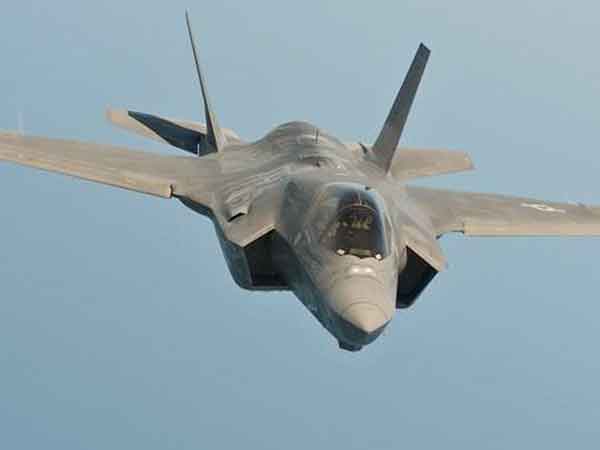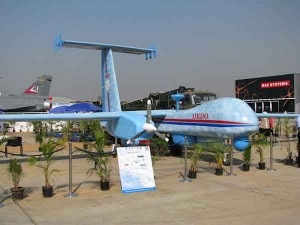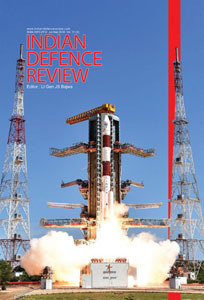Advantage Unmanned Aerial Vehicles
High-fidelity automated flight controls, high-speed computations, revolution in precision navigation and very secure, near break-proof, data-links have allowed development and proliferation of UAVs. With pilot out of the cockpit and attendant benefits of longer endurance and reduced risk to life, it opened a new chapter in the history of warfare. Drones have also made air war more indiscriminate and in turn bloodier. Hundreds of strikes by UAVs in Afghanistan and Pakistan underscore this dramatic change in the way air power is employed today. Capability for long-range precision strikes by PGM-carrying drones was demonstrated in the First Gulf War.
The US has already modified F-4s and F-16s to fly them remotely…
Modern drones provide many of the best features of both cruise missiles and manned aircraft. Despite their great capabilities, they are predominantly still used for information collection in form of electro-optical data. Systems such as Aerovironment’s Wasp, Puma and Raven; Insitu’s ScanEagle and Textron’s Shadow are in operation. Even the Predator variant MQ-9 Reaper, a platform meant for armed strikes, is predominantly employed for intelligence, surveillance, and reconnaissance missions.
The larger systems such as Northrop Grumman’s Global Hawk and Lockheed Martin’s stealthy RQ-170 Sentinel are intended solely to gather intelligence. Armed drones continue to remain a niche function. They are useful in situations where real-time tactical intelligence is required in order to launch a weapon and the operating environment is extremely benign. They can loiter in the area of a suspected target, waiting for positive identification and the proper time to strike with the least possibility of inflicting collateral damage. Armed drones now attack targets that in the past would have required an invasion with thousands of heavily armed troops, displacing huge numbers of civilians and destroying valuable property along the way. Some analysts say that drones in current counterterrorism operations are promoting a ‘license to kill’.
Unmanned aircraft already take off and land by themselves including on a moving aircraft carrier (Northrop GrummanX-47B). Autonomous air refuelling would leave UAVs on station for months. Lockheed Martin’s UCLASS drone ‘Sea Ghost’ looks rather like a stealth bomber and is expected to carry 1,000-lb class weapons. Boeing’s Phantom Eye is used as an eye-in-the-sky in battle zones. It is a High Altitude Long Endurance (HALE) vehicle that can spend over four days in continuous flight. The US has already modified F-4s and F-16s to fly them remotely. In France, Dassault leads a multi-nation delta wing UCAV ‘Neuron’ project of the size of Mirage 2000.
The DRDO is developing a Medium Altitude Long Endurance UAV named ‘Rustam’ to replace/supplement the Heron UAVs in service…
UK’s Strategic Unmanned Air Vehicle programme ‘Taranis’ is headed by BAE Systems and is partnered by GE Aviation, Rolls Royce and QinetiQ. This will be a supersonic autonomous stealth bomber with intercontinental range. US Department of Defense Hypersonic (Mach 6) Strike Bomber is likely to be optionally manned. The US Army’s dramatic shift to a nearly all-unmanned flight over the next three decades is embedded in the UAS roadmap. The USAF’s vision document indicates that by 2047, every mission including heavy-lift, would be unmanned. UAVs have become too attractive and potent military asset for any significant power to ignore. The USAF has 300-plus active Global Hawk, Predator and Reaper drones in its inventory. That number is expected to grow to 450 by fiscal 2017.
Since 2011, the USAF has trained more UAV pilots than fighter and bomber pilots combined. UAVs are best for strikes on heavily defended targets. UAVs have much lower training costs and can best concentrate on ISR and BAS leaving air superiority to be handled by manned fighters. Unmanned Combat Aerial Vehicles (UCAV) can perform the Suppression of Enemy Air Defence (SEAD) mission and pre-emptive strikes ahead of main force package. UAVs operate at a fraction of the total Life Cycle Costs of manned systems. Mixed manned and unmanned formations, with airborne crew controlling swarms of UAVs including their attack and weapon release is already a reality.
The US Navy already has a mixed force squadron with manned and Fire Scout unmanned helicopters. UAVs will one day carry the nuclear weapon. By 2030, flying robots could be programmed with automatic target engagement logic and would open fire only after going through a checklist of preset engagement rules. By 2047, the USAF foresees fewer pilots and many more stand-alone UAVs. UAVs will thus be a great bet to take on the mission BAS.
BAS Aircraft Choices for India
The IAF’s top of the line air superiority fighter Sukhoi Su-30 MKI has multi-role capability. Finally, the IAF will have around 14 Squadrons. The aircraft already has state-of-the-art navigation and targeting avionics. Its radar can detect ground targets such as tanks at 40 to 50 km. The Israeli ‘Litening’ targeting pod is used for laser guided munitions. It includes long-range FLIR and a TV camera that also support cluster and general purpose bombs. They will one day have AESA radar with over 450 km aerial range giving it mini-AWACS features, and better ground resolution.
A satellite navigation system permits all-weather operations. It has a host of air-defence weapons and a powerful self-protection suite for ‘offensive defence’. The air-to-surface armaments include anti-radiation missiles, TV-guided bombs/missiles, anti-shipping weapons, the BrahMos and Nirbhay cruise missile with ranges up to 1,000 km, Laser guided bombs up to 1,500 kg and a variety of cluster and gravity bombs. In addition to its other roles like sanitising the air space, the SU-30 will be a great aircraft to shape the battlefield.
India’s solid-fuel, DRDO-made tactical missile Prahaar has a range of 150 km with the capability to carry both tactical and strategic warheads…
Two squadrons of upgraded multi-role Mirage 2000, four of Anglo-French Jaguar and two of upgraded MiG-27 dedicated strike aircraft would also take on air interdiction and BAS roles. Five squadrons of upgraded MiG-21 Bison could support CAS missions. Later, indigenous HAL Light Combat Aircraft Tejas will be equipped with FLIR targeting pod and will also support BAS and CAS missions. The Beriev A-50 (EL/W-2090 Phalcon) AEW&C and later DRDO AEW&C Embraer ERJ-145 will give command and control support to the BAS missions into enemy territory. The weaponised version of HAL ALH Dhruv and two squadrons of Mi-25/35 attack helicopters will support CAS missions.
HAL is developing the Light Combat Helicopter that will be capable to operate from altitudes of 6,500 metres. The IAF will acquire around 68 for anti-infantry and anti-armour role. Many more will be acquired by Indian Army. 22 Boeing AH-64E Apache attack helicopters on order for the IAF and 33 planned to be acquired by the Indian Army, will all take on CAS and limited BAS missions. IAI Harpy combat UAV will fly anti-radar missions. The IAF is also trying to acquire UCAVs with low radar cross-section, high service ceiling, 925 km-range and capability to carry PGMs in an internal weapons bay.
The DRDO is developing a Medium Altitude Long Endurance UAV named ‘Rustam’ to replace/supplement the Heron UAVs in service. They are also developing the Autonomous Unmanned Research Aircraft a UCAV which will be a tactical stealth aircraft built largely with composites, and capable of delivering laser-guided strike weapons. All these will be part of the great basket of BAS aircraft.
Tactical Surface-to-Surface Missiles
The tactical ballistic missiles are designed for short-range battlefield use. They are an extension of the artillery. Typically they have range under 300 km. They are usually mobile for quicker re-deployment and also better survivability. They carry a variety of warheads to target enemy facilities, assembly areas, artillery and other targets behind the front lines. Warheads can include conventional high explosive, chemical, biological or nuclear warheads. Typically, tactical nuclear weapons are limited in their total yield compared to strategic rockets. They are better suited to responding to developments on the battlefield.
BAS missions will have to be shared between fighter aircraft, UAVs and surface-to-surface missiles…
For many nations, tactical missiles represent the upper limit of their land-based military equipment. They are a powerful weapon at very economical price. Only very modern air defense systems such as the Russian S-400 Triumph or Israeli Iron Dome have some ability to intercept tactical missiles. In India’s neighbourhood, the Chinese WS-1 and Pakistan’s Nasr (Hatf IX), Abdali (Hatf II), Ghaznavi (Hatf III) are all between the ranges of 60 to 300 km. Nasr is purported to have a tactical nuclear warhead. India’s solid-fuel, DRDO-made tactical missile Prahaar has a range of 150 km with the capability to carry both tactical and strategic warheads. Most of these will have the battlefield support role.
BAS Planning Imperatives
It is clear that BAS missions will have to be shared between fighter aircraft, UAVs and surface-to-surface missiles. The selection of BAS/interdiction targets would have to be evolved jointly between army and air force. The end-state requirements would have to be clearly defined and achieved. The timing of the strike has to be linked to the ground plan. Timely intelligence would be critical. While CAS would be at Corps HQ level, the BAS will best be planned at Command HQ level. BAS strikes will be part of a larger offensive multi-mission package involving large number of aircraft. Missions will integrate buddy UAVs. Missiles strikes, SEAD and Air Superiority missions will precede and support. The air package will be a mix of high and mid-level fighters.
Fifth Generation Aircraft Missions for India
Thus, it is clear that the IAF has enough air assets to support the operationally very important BAS mission. In addition to targeting enemy airfields, movement of enemy ground forces, especially their strike corps and reserves would have to be thwarted. In the mountainous region, India would have to interdict and close supply routes by air-action. The Indo-Russian FGFA, which is a derivative of the in-development single-seat Russian Sukhoi PAK-FA, will join the IAF by the end of this decade.
Large numbers will be inducted to replace MiG-29s and MiG-27s. HAL and ADA have also started design work on a 20-tonne class, fifth generation stealth multi-role Advanced Medium Combat Aircraft (AMCA) to replace the Jaguar and Mirage 2000 fighters one day. The IAF targets around 250 AMCAs. Both will have multi mission capability but the IAF will have enough air assets for BAS missions and will be able leave these expensive fifth-generation aircraft for air-superiority and strategic missions.








Further to my previous post the following quote is very illuminating:
“Gen. Konashenko gave advance notice to the US not to complain … also took a swipe at US military analysts who brag about the stealth aircraft by saying “all the illusions of amateurs about the existence of ‘invisible’ jets will face a disappointing reality”.”
Link: http://blogs.rediff.com/mkbhadrakumar/2016/10/06/us-russia-communicate-despite-syria-row/
So far I have not come across something really needed and less costly . First of all, none of the fighter planes can escape from Multiple missile attacks like S-400 and Barrak-8 missiles. What is the use of fighter plane having stealth body? Developing digital jammer is cheaper than any fighter plane . The fighter plane is the weapon carrying the vehicle. All the fighter planes have a small radar to guide missiles properly. These radars can be jammed easily . Please read the article
“Don’t panic, but Pentagon now thinks Russia can jam American “
“…they generally include all-aspect stealth even when fully armed …” –
Not clear what is the implication of “stealth” here. I would have thought any modern radar warning receiver set built on e.g. superhet or scanning technology, will be capable of detecting any incoming aircraft that navigates with pulsed radar. I wonder whether the IAF has mastered operating AWACS. It should be obvious then what I am pointing at. Of course, operating RWRs require high level of scientific skill.